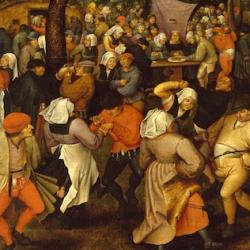The notion that the church is an “extension” of the incarnation has been a source of controversy. For many, especially Protestant theologians, the notion seems to blur the necessary distinction between Head and body, Husband and bride, Lord and servants. If the church is an extension of the incarnation, the church may become as divine, inviolable, infallible as Jesus is.
When we take John’s gospel and Revelation together, we have a way of thinking about the issue that may avoid these problems. John famously describes the incarnation as a “tabernacling” (John 1:14): The word became flesh and tabernacled among us (ho logos sarx egeneto kai eskenosen en hemin). It’s the beginning of John’s temple Christology, which runs through his entire gospel.
But the tabernacling analogy isn’t just a way of describing the church. In Revelation, it becomes a way of describing God’s relation to the church. One of the blessings promised those who come through tribulation and stand before God’s throne is this: “He who sits on the throne shall tabernacle over them” (Revelation 7:15; Greek, ho kathemenos epi tou thronou skenosei ep’ autous). Faithful witnesses are not the incarnation of the word; but faithful witnesses do come under the same covering. We might put it this way: the Word and the saints are brought under the same covering, into the same tent, which the Enthroned One provides.
Similar language is used in Revelation 21:3, where the verb skenoo describes the descent of the bride from heaven, which completes God’s purpose of setting up His tabernacle (skene) among men. Here the bride herself seems to make an incarnational movement, descending from heaven like the Word to pitch a tent, God’s tent, on earth. We might connect this back to Revelation 7 and John 1: The Word became flesh and tabernacled among us; faithful witnesses are invited into the tent with the Word; and then that tabernacle, in which Word and witnesses dwell together, descends to earth as a bride.
These descriptions are often taken as eschatological visions of the church of the end. Even if that is so, we might still be able to apply them to the church in history, which, if not a tabernacle of God among men, is a tabernacle-in-preparation.















